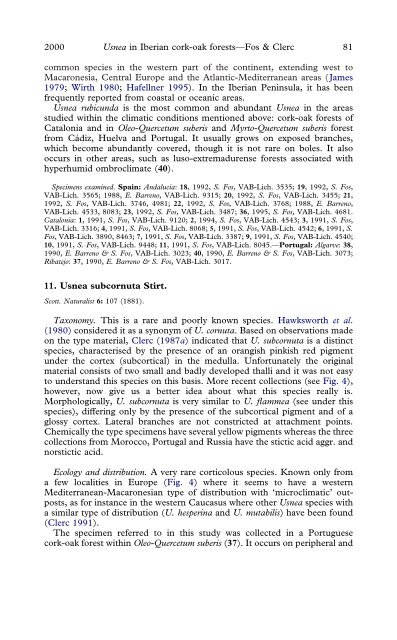the lichen genus usnea on quercus suber in iberian cork-oak forests
the lichen genus usnea on quercus suber in iberian cork-oak forests
the lichen genus usnea on quercus suber in iberian cork-oak forests
Create successful ePaper yourself
Turn your PDF publications into a flip-book with our unique Google optimized e-Paper software.
2000 Usnea <strong>in</strong> Iberian <strong>cork</strong>-<strong>oak</strong> <strong>forests</strong>—Fos & Clerc 81<br />
comm<strong>on</strong> species <strong>in</strong> <str<strong>on</strong>g>the</str<strong>on</strong>g> western part of <str<strong>on</strong>g>the</str<strong>on</strong>g> c<strong>on</strong>t<strong>in</strong>ent, extend<strong>in</strong>g west to<br />
Macar<strong>on</strong>esia, Central Europe and <str<strong>on</strong>g>the</str<strong>on</strong>g> Atlantic-Mediterranean areas (James<br />
1979; Wirth 1980; Hafellner 1995). In <str<strong>on</strong>g>the</str<strong>on</strong>g> Iberian Pen<strong>in</strong>sula, it has been<br />
frequently reported from coastal or oceanic areas.<br />
Usnea rubicunda is <str<strong>on</strong>g>the</str<strong>on</strong>g> most comm<strong>on</strong> and abundant Usnea <strong>in</strong> <str<strong>on</strong>g>the</str<strong>on</strong>g> areas<br />
studied with<strong>in</strong> <str<strong>on</strong>g>the</str<strong>on</strong>g> climatic c<strong>on</strong>diti<strong>on</strong>s menti<strong>on</strong>ed above: <strong>cork</strong>-<strong>oak</strong> <strong>forests</strong> of<br />
Catal<strong>on</strong>ia and <strong>in</strong> Oleo-Quercetum <strong>suber</strong>is and Myrto-Quercetum <strong>suber</strong>is forest<br />
from Cádiz, Huelva and Portugal. It usually grows <strong>on</strong> exposed branches,<br />
which become abundantly covered, though it is not rare <strong>on</strong> boles. It also<br />
occurs <strong>in</strong> o<str<strong>on</strong>g>the</str<strong>on</strong>g>r areas, such as luso-extremadurense <strong>forests</strong> associated with<br />
hyperhumid ombroclimate (40).<br />
Specimens exam<strong>in</strong>ed. Spa<strong>in</strong>: Andalucía: 18, 1992, S. Fos, VAB-Lich. 3535; 19, 1992, S. Fos,<br />
VAB-Lich. 3565; 1988, E. Barreno, VAB-Lich. 9315; 20, 1992, S. Fos, VAB-Lich. 3455; 21,<br />
1992, S. Fos, VAB-Lich. 3746, 4981; 22, 1992, S. Fos, VAB-Lich. 3768; 1988, E. Barreno,<br />
VAB-Lich. 4533, 8083; 23, 1992, S. Fos, VAB-Lich. 3487; 36, 1995, S. Fos, VAB-Lich. 4681.<br />
Catal<strong>on</strong>ia: 1, 1991, S. Fos, VAB-Lich. 9120; 2, 1994, S. Fos, VAB-Lich. 4543; 3, 1991, S. Fos,<br />
VAB-Lich. 3316; 4, 1991, S. Fos, VAB-Lich. 8068; 5, 1991, S. Fos, VAB-Lich. 4542; 6, 1991, S.<br />
Fos, VAB-Lich. 3890, 8463; 7, 1991, S. Fos, VAB-Lich. 3387; 9, 1991, S. Fos, VAB-Lich. 4540;<br />
10, 1991, S. Fos, VAB-Lich. 9448; 11, 1991, S. Fos, VAB-Lich. 8045.—Portugal: Algarve: 38,<br />
1990, E. Barreno & S. Fos, VAB-Lich. 3023; 40, 1990, E. Barreno & S. Fos, VAB-Lich. 3073;<br />
Ribatejo: 37, 1990, E. Barreno & S. Fos, VAB-Lich. 3017.<br />
11. Usnea subcornuta Stirt.<br />
Scott. Naturalist 6: 107 (1881).<br />
Tax<strong>on</strong>omy. This is a rare and poorly known species. Hawksworth et al.<br />
(1980) c<strong>on</strong>sidered it as a syn<strong>on</strong>ym of U. cornuta. Based <strong>on</strong> observati<strong>on</strong>s made<br />
<strong>on</strong> <str<strong>on</strong>g>the</str<strong>on</strong>g> type material, Clerc (1987a) <strong>in</strong>dicated that U. subcornuta is a dist<strong>in</strong>ct<br />
species, characterised by <str<strong>on</strong>g>the</str<strong>on</strong>g> presence of an orangish p<strong>in</strong>kish red pigment<br />
under <str<strong>on</strong>g>the</str<strong>on</strong>g> cortex (subcortical) <strong>in</strong> <str<strong>on</strong>g>the</str<strong>on</strong>g> medulla. Unfortunately <str<strong>on</strong>g>the</str<strong>on</strong>g> orig<strong>in</strong>al<br />
material c<strong>on</strong>sists of two small and badly developed thalli and it was not easy<br />
to understand this species <strong>on</strong> this basis. More recent collecti<strong>on</strong>s (see Fig. 4),<br />
however, now give us a better idea about what this species really is.<br />
Morphologically, U. subcornuta is very similar to U. flammea (see under this<br />
species), differ<strong>in</strong>g <strong>on</strong>ly by <str<strong>on</strong>g>the</str<strong>on</strong>g> presence of <str<strong>on</strong>g>the</str<strong>on</strong>g> subcortical pigment and of a<br />
glossy cortex. Lateral branches are not c<strong>on</strong>stricted at attachment po<strong>in</strong>ts.<br />
Chemically <str<strong>on</strong>g>the</str<strong>on</strong>g> type specimens have several yellow pigments whereas <str<strong>on</strong>g>the</str<strong>on</strong>g> three<br />
collecti<strong>on</strong>s from Morocco, Portugal and Russia have <str<strong>on</strong>g>the</str<strong>on</strong>g> stictic acid aggr. and<br />
norstictic acid.<br />
Ecology and distributi<strong>on</strong>. A very rare corticolous species. Known <strong>on</strong>ly from<br />
a few localities <strong>in</strong> Europe (Fig. 4) where it seems to have a western<br />
Mediterranean-Macar<strong>on</strong>esian type of distributi<strong>on</strong> with ‘microclimatic’ outposts,<br />
as for <strong>in</strong>stance <strong>in</strong> <str<strong>on</strong>g>the</str<strong>on</strong>g> western Caucasus where o<str<strong>on</strong>g>the</str<strong>on</strong>g>r Usnea species with<br />
a similar type of distributi<strong>on</strong> (U. hesper<strong>in</strong>a and U. mutabilis) have been found<br />
(Clerc 1991).<br />
The specimen referred to <strong>in</strong> this study was collected <strong>in</strong> a Portuguese<br />
<strong>cork</strong>-<strong>oak</strong> forest with<strong>in</strong> Oleo-Quercetum <strong>suber</strong>is (37). It occurs <strong>on</strong> peripheral and

















